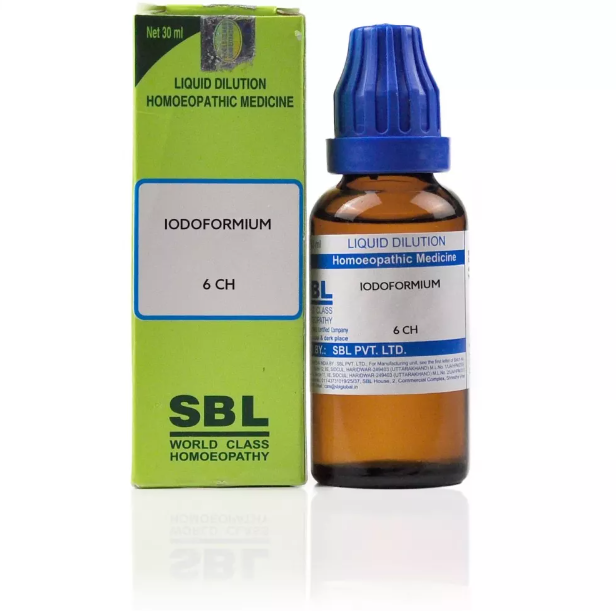IODOFORMIUM 6C, 12C, 30C, 200C, 1M, 10M USES AND SYMPTOMS
 Iodoformium
Iodoformium
(Iodoform)
lodof.
Useful in treating tubercular meningitis both locally on the head and internally (Bac.). Effective for tuberculous conditions and subacute and chronic diarrhea in children.
Head: Sharp neuralgic pain. Heavy sensation as if head cannot be lifted from the pillow. Occipital itching. Meningitis. Sleep disrupted by sighing and cries. Very drowsy.
Eyes: Pupils dilated; contract unequally, react poorly. Diplopia. Deteriorating vision due to retro-bulbar neuritis, central scotoma, partial optic disc atrophy.
Abdomen: Scaphoid abdomen. Chronic diarrhea possibly linked to tuberculosis. Distended abdomen; enlarged mesenteric glands. Cholera infantum. Chronic diarrhea; greenish, watery, undigested stools, with irritability.
Chest: Sore pain at the apex of the right lung. Sensation of weight on the chest, feeling of smothering. Cough and wheezing at bedtime. Pain in the left breast, like a hand grasping at the base of the heart. Hemoptysis (phthisis). Asthmatic breathing.
Extremities: Legs weak; unable to stand or walk with eyes closed (locomotor ataxia). Knee weakness when climbing stairs.
SYMPTOMS OF IODOFORMIUM
Head:
Sharp neuralgic pain
Heavy sensation as if head cannot be lifted from the pillow
Itching in the occiput
Meningitis
Sleep disrupted by sighing and cries
Very drowsy
Eyes:
Dilated pupils
Pupils contract unequally and react poorly
Diplopia (double vision)
Deteriorating vision due to retro-bulbar neuritis
Central scotoma
Partial atrophy of the optic disc
Abdomen:
Scaphoid abdomen
Chronic diarrhea possibly linked to tuberculosis
Distended abdomen
Enlarged mesenteric glands
Cholera infantum
Chronic diarrhea with greenish, watery, undigested stools, accompanied by irritability
Chest:
Sore pain at the apex of the right lung
Sensation of weight on the chest, feeling of smothering
Cough and wheezing at bedtime
Pain in the left breast, like a hand grasping at the base of the heart
Hemoptysis (coughing up blood, associated with phthisis)
Asthmatic breathing
Extremities:
Weak legs; inability to stand or walk with eyes closed (locomotor ataxia)
Knee weakness when climbing stairs
selection of the potency
Individualization:
- Homeopathy is based on the principle of treating the individual, not just the disease. The unique symptoms and characteristics of the person are crucial in determining the most suitable potency.
Intensity of Symptoms:
- The intensity of the symptoms guides the choice of potency. If the symptoms are intense and acute, a lower potency (e.g., 6C, 30C) might be considered. For chronic conditions with less intensity, higher potencies (e.g., 200C, 1M) may be appropriate.
Sensitivity of the Patient:
- Some individuals are more sensitive to homeopathic remedies, while others may require higher potencies. The practitioner considers the patient’s sensitivity when selecting the potency.
Acute vs. Chronic Conditions:
- Lower potencies are often used for acute conditions, while higher potencies may be considered for chronic or long-standing issues.
Previous Response to Potencies:
- The patient’s response to previous homeopathic treatments helps guide the choice of potency. If a particular potency has been effective in the past, it may be repeated or adjusted as needed.
Vital Force and Susceptibility:
- Homeopathy views illness as a disturbance in the vital force. The practitioner assesses the patient’s overall vitality and susceptibility to determine the appropriate potency.
Aggravation or Amelioration:
- The direction of the symptom response (aggravation or amelioration) after taking a remedy can influence the choice of potency.
Miasmatic Considerations:
- In classical homeopathy, the concept of miasms (inherited disease tendencies) is considered. The practitioner take this into account when selecting the potency.
Practitioner Experience:
- The experience and preference of the homeopathic practitioner play a role. Some practitioners may have success with certain potencies based on their clinical experience.
SAFETY INFORMATION
- Do not exceed the recommended dose by physician
- Keep out of the reach of children
- Store in a cool dry place away from direct sunlight
- Maintain half an hour gap between food/drink/any other medicines and homoeopathic medicine
- Avoid any strong smell in the mouth while taking medicine e.g. camphor, garlic, onion, coffee, hing
Medicine images use for reference only selection of homeopathic medicine depends on the individual’s specific symptoms and overall constitution. Moreover, homeopathy is a holistic system of medicine that treats the individual as a whole. In addition to addressing the physical symptoms, it takes into account the emotional and mental state of the person. Consequently, it’s crucial to consult with a qualified homeopathic practitioner for personalized treatment.
The information provided on this website is intended solely for educational purposes. Always seek the advice of your physician or other qualified health provider.
